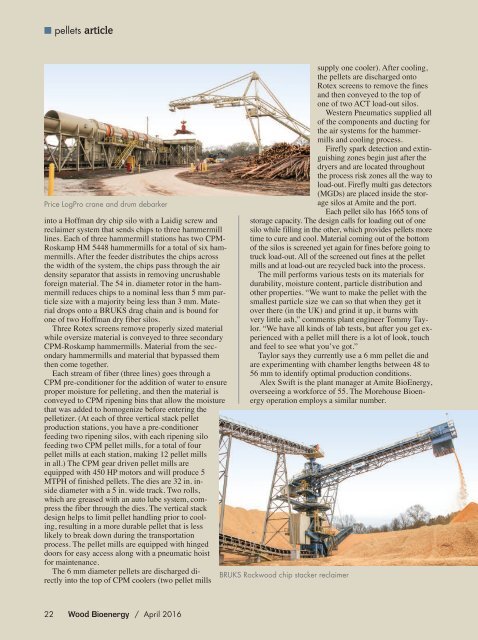Create successful ePaper yourself
Turn your PDF publications into a flip-book with our unique Google optimized e-Paper software.
■ pellets article<br />
Price LogPro crane and drum debarker<br />
into a Hoffman dry chip silo with a Laidig screw and<br />
reclaimer system that sends chips to three hammermill<br />
lines. Each of three hammermill stations has two CPM-<br />
Roskamp HM 5448 hammermills for a total of six hammermills.<br />
After the feeder distributes the chips across<br />
the width of the system, the chips pass through the air<br />
density separator that assists in removing uncrushable<br />
foreign material. <strong>The</strong> 54 in. diameter rotor in the hammermill<br />
reduces chips to a nominal less than 5 mm particle<br />
size with a majority being less than 3 mm. Material<br />
drops onto a BRUKS drag chain and is bound for<br />
one of two Hoffman dry fiber silos.<br />
Three Rotex screens remove properly sized material<br />
while oversize material is conveyed to three secondary<br />
CPM-Roskamp hammermills. Material from the secondary<br />
hammermills and material that bypassed them<br />
then come together.<br />
Each stream of fiber (three lines) goes through a<br />
CPM pre-conditioner for the addition of water to ensure<br />
proper moisture for pelleting, and then the material is<br />
conveyed to CPM ripening bins that allow the moisture<br />
that was added to homogenize before entering the<br />
pelletizer. (At each of three vertical stack pellet<br />
production stations, you have a pre-conditioner<br />
feeding two ripening silos, with each ripening silo<br />
feeding two CPM pellet mills, for a total of four<br />
pellet mills at each station, making 12 pellet mills<br />
in all.) <strong>The</strong> CPM gear driven pellet mills are<br />
equipped with 450 HP motors and will produce 5<br />
MTPH of finished pellets. <strong>The</strong> dies are 32 in. inside<br />
diameter with a 5 in. wide track. Two rolls,<br />
which are greased with an auto lube system, compress<br />
the fiber through the dies. <strong>The</strong> vertical stack<br />
design helps to limit pellet handling prior to cooling,<br />
resulting in a more durable pellet that is less<br />
likely to break down during the transportation<br />
process. <strong>The</strong> pellet mills are equipped with hinged<br />
doors for easy access along with a pneumatic hoist<br />
for maintenance.<br />
<strong>The</strong> 6 mm diameter pellets are discharged directly<br />
into the top of CPM coolers (two pellet mills<br />
supply one cooler). After cooling,<br />
the pellets are discharged onto<br />
Rotex screens to remove the fines<br />
and then conveyed to the top of<br />
one of two ACT load-out silos.<br />
Western Pneumatics supplied all<br />
of the components and ducting for<br />
the air systems for the hammermills<br />
and cooling process.<br />
Firefly spark detection and extinguishing<br />
zones begin just after the<br />
dryers and are located throughout<br />
the process risk zones all the way to<br />
load-out. Firefly multi gas detectors<br />
(MGDs) are placed inside the storage<br />
silos at Amite and the port.<br />
Each pellet silo has 1665 tons of<br />
storage capacity. <strong>The</strong> design calls for loading out of one<br />
silo while filling in the other, which provides pellets more<br />
time to cure and cool. Material coming out of the bottom<br />
of the silos is screened yet again for fines before going to<br />
truck load-out. All of the screened out fines at the pellet<br />
mills and at load-out are recycled back into the process.<br />
<strong>The</strong> mill performs various tests on its materials for<br />
durability, moisture content, particle distribution and<br />
other properties. “We want to make the pellet with the<br />
smallest particle size we can so that when they get it<br />
over there (in the UK) and grind it up, it burns with<br />
very little ash,” comments plant engineer Tommy Taylor.<br />
“We have all kinds of lab tests, but after you get experienced<br />
with a pellet mill there is a lot of look, touch<br />
and feel to see what you’ve got.”<br />
Taylor says they currently use a 6 mm pellet die and<br />
are experimenting with chamber lengths between 48 to<br />
56 mm to identify optimal production conditions.<br />
Alex Swift is the plant manager at Amite BioEnergy,<br />
overseeing a workforce of 55. <strong>The</strong> Morehouse Bioenergy<br />
operation employs a similar number.<br />
BRUKS Rockwood chip stacker reclaimer<br />
22 Wood Bioenergy / April 2016


